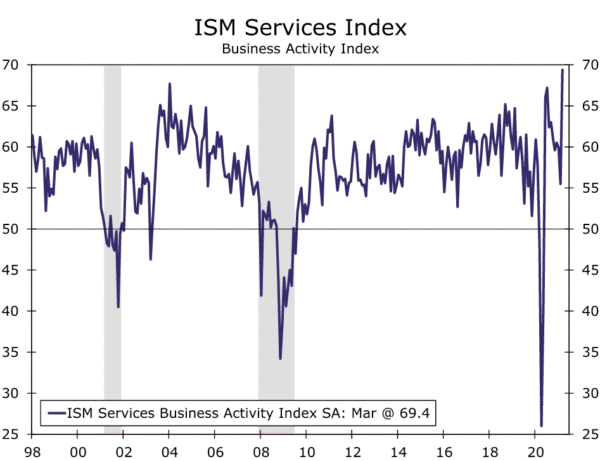Summary
The ISM Services PMI surged more than eight points to 63.7 in March, signaling a record pace of expansion. The jump in the new orders and employment components is indicative of coming activity and suggests the hard-hit service sector is finally gaining some real momentum. That said, the supply chain issues most evident in the manufacturing sector are rippling through the broader economy.
Smokin’
The record high in the ISM Services PMI is just the latest data pointing to an economy starting to boom. The more than eight-point jump to 63.7 follows a pickup in the Markit Services index and medley of services surveys from various regional Federal Reserve Banks.
The broadening signs of growth were evident with all 18 industries reporting an increase in March. The index on current business activity climbed to an all-time high of 69.4, as the unwinding of last month’s weather disruptions coincided with the COVID picture brightening and another round of substantial fiscal support hitting bank accounts.
The solid reading does not appear to be a flash in the pan either. The new orders sub-index surged to an eight-month high of 67.2 and indicates the surge in activity was more than just catch up after last month’s disruptions. In another sign the pickup has legs, the employment index leapt 4.5 points to its highest reading in nearly two years. Businesses would not be hiring if they did not think the rebound in activity was sustainable. The increase backs up March’s better-than-expected payroll gains published last Friday.
Manufacturers Don’t Have a Monopoly on Supply Chain Issues
Re-opening pains, however, remain evident. Like the manufacturing ISM survey, the headline was propped up by lengthening supplier delivery times. Some services are inherently tied to the goods market, such as transportation, wholesale trade and retail, which all reported slower delivery times last month. In addition, the “Services PMI” also includes some goods producing industries, like construction, mining and agriculture, all of which also reported longer delivery times. But even in more clear-cut services industries, businesses are having trouble getting their hands on some inputs they need. Respondents in the accommodation & food services, arts & entertainment and information industries all cited supply challenges. In other words, it’s more than just manufacturers struggling with the intense strains of supply chains at present. Delays of products are being felt across the whole economy.
Not surprising then given the disruptions along with surging demand, input prices continue to head higher. The prices paid index climbed 2.2 points from what was already a 12-year high, in yet another sign of growing inflationary pressure.
At Your Service
This report bodes well for a coming surge in services spending. Despite the continued mention of logistical challenges and inventory shortages, respondents’ comments had a hint of optimism. Respondents across industries highlighted the improving public health backdrop and increased expectations around coming demand.
The previously mentioned record-high reading for new orders supports our expectation for services spending to ramp up more meaningfully beginning in the second quarter. Our forecast has services spending leading the consumer recovery this year as vaccinations are more widespread and restrictions are further eased. This report was good news for the sector and suggests we are beginning to see momentum take hold after the sector has been constrained for more than a year.


 Signal2forex.com - Best Forex robots and signals
Signal2forex.com - Best Forex robots and signals




